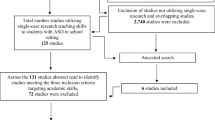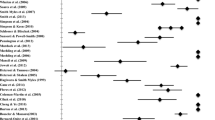Abstract
The ability for individualization and the wide array of available apps have made portable electronic devices popular for use with students with autism, particularly in the classroom. The current study examined the effectiveness of using iPads to deliver academic interventions to students with autism. Seven studies using iPads with single-case deigns and small samples were analyzed through both Tau-U and hierarchical linear modeling (HLM) techniques. Analysis of potential moderating variables indicated no significant differences across academic subject, grade of participants, or number of sessions. However, the HLM analyses revealed a significant difference for the introduction of the intervention. Discussion focuses on the use of iPads for academic interventions for students with autism and recommendations for practitioners.
Similar content being viewed by others
References
*Indicates Studies Used for Meta-Analytic Data
Agrawal, J. (2013). The effects of explicit instruction with manipulatives on the fraction skills of students with autism. (Unpublished doctoral dissertation). George Mason University, Fairfax, VA.
Arthanat, S., Curtin, C., & Knotak, D. (2013). Comparative observations of learning engagement by students with development disabilities using an iPad and computer: a pilot study. Assistive Technology, 25, 204–214.
Bouck, E. C., & Flanagan, S. M. (2010). Visual manipulatives: What are they and how teachers can use them? Intervention in School and Clinic, 45, 186–191.
*Browder, D. M., Root, J. R., Wood, L., & Allison, C. (2017). Effects of a story-mapping procedure using the iPad on the comprehension of narrative texts by students with autism spectrum disorder. Focus on Autism and Other Developmental Disabilities, 32, 243–255.
Bruni, T. P., Drevon, D., Hixon, M., Wyse, R., Corcoran, S., & Fursa, S. (2017). The effect of functional behavior assessment on school-based interventions: a meta-analysis of single-case research. Psychology in the Schools, 54, 351–369.
*Burton, C. E., Anderson, D. H., Prater, M. A., & Dyches, T. T. (2013). Video self-modeling on an iPad to teach functional math skills to adolescents with autism and intellectual disability. Focus on Autism and Other Developmental Disabilities, 28(2), 67–77.
Cafiero, J. M. (2012). Technology supports for individuals with autism spectrum disorder. Journal of Special Education Technology, 27(1), 64–76.
Christensen, D. L., Baio, J., Braun, K., Bilder, D., Charles, J., Constantino, J. N., & Yeargin-Allsopp, M. (2016). Prevalence and characteristics of autism spectrum disorder among children aged 8 years. Surveillance Summaries, 65(3), 1–23.
Cumming, T. M., & Rodriguez, C. D. (2013). Integrating the iPad into language arts instruction for students with disabilities: engagement and perspectives. Journal of Special Education Technology, 28, 43–52.
Doody, K. R. (2015). GrAPPling with how to teach social skills? Try tapping into digital technology. Journal of Special Education Technology, 30(2), 122–127.
Douglas, K. H., Wojcik, B. W., & Thompson, J. R. (2011). Is there an app for that? Journal of Special Education Technology, 27(2), 59–70.
*Emerson, J. (2013). The effect on using the iPad to enhance sight word acquisition of students with autism. Doctoral dissertation. Retrieved from http://rdw.rowan.edu/etd/107/, http://dspace.rowan.edu/handle/10927/841
Falloon, G. (2013). Young students using iPads: app design and content influences on their learning pathways. Computers & Education, 68, 505–521.
Holifield, C., Goodman, J., Hazelkom, M., & Heflin, J. (2010). Using self-monitoring to increase attending to task and academic accuracy in children with ASD. Focus on Autism and Other Development Disabilities, 25, 230–238.
*Jowett, E. L., Moore, D. W., & Anderson, A. (2012). Using an iPad-based video modelling package to teach numeracy skills to a child with an autism spectrum disorder. Developmental Neurorehabilitation, 15(4), 304–312.
*Kagohara, D. M., Sigafoos, J., Achmadi, D., O’Reilly, M., Lancioni, G. (2012). Teaching children with autism spectrum disorders to check the spelling of words. Research in Autism Spectrum Disorders, 6, 304–310.
Kagohara, D. M., van der Meer, L., Ramdoss, S., O’Reilly, M. F., Lancioni, G. E., Davis, T. N., & Sigafoos, J. (2013). Using iPods(®) and iPads(®) in teaching programs for individuals with developmental disabilities: a systematic review. Research in Developmental Disabilities, 34, 147–156.
Keen, D., Webster, A., & Ridley, G. (2016). How well are children with autism spectrum disorder doing academically at school? An overview of the literature. Autism, 20, 276–294.
King, A. M., Thomeczek, M., Voreis, G., & Scott, V. (2014). iPad use in children and young adults with autism spectrum disorder: an observational study. Child Language Teaching & Therapy, 30(2), 159–173.
Knight, V., McKissick, B. R., & Saunders, A. (2013). A review of technology-based interventions to teach academic skills to students with autism spectrum disorder. Journal of Autism and Developmental Disorders, 43, 2628–2648.
Kratochwill, T. R., Hitchcock, J. H., Horner, R. H., Levin, J. R., Odom, S. L., Rindskopf, D. M., & Shadish, W. R. (2013). Single-case intervention research design standards. Remedial and Special Education, 34, 26–38.
Ledbetter-Cho, K., O’Reilly, M., Lang, R., Watkins, L., & Lim, N. (2018). Meta-analysis of tablet-mediated interventions for teaching academic skills to individuals with autism. Journal of Autism and Developmental Disorders, 1–16. https://doi.org/10.1007/s10803-018-3573-2.
Lee, C. Y., & Cherner, T. S. (2015). A comprehensive evaluation rubric for assessing instructional apps. Journal of Information Technology Education: Research, 14, 21–53.
Moeyaert, M., Maggin, D., & Verkuilen, J. (2016). Reliability, validity, and usability of data extraction programs for single-case research designs. Behavior Modification, 40(6), 874–900.
Ok, M. W., & Bryant, D. P. (2015). Effects of a strategic intervention with iPad practice on the multiplication fact performance of fifth-grade students with learning disabilities. Learning Disability Quarterly, 39, 136–148.
Ok, M. W., & Kim, W. (2017). Use of iPads and iPods for academic performance and engagement of preK-12 students with disabilities: a research synthesis. Exceptionality, 25, 54–75.
Ok, M. W., Kim, M. K., Kang, E. Y., & Bryant, B. R. (2016). How to find good apps: an evaluation rubric for instructional apps for teaching students with learning disabilities. Intervention in School and Clinic, 51, 244–252.
Parker, R. I., & Vannest, K. J. (2009). An improved effect size for single-case research: nonoverlap of all pairs. Behavior Therapy, 40, 357–367.
Parker, R. I., Vannest, K. J., David, J. L., & Sauber, S. B. (2011). Combining non-overlap and trend for single-case research: Tau-U. Behavior Therapy, 42, 284–299.
Parker, R. I., Vannest, K. J., & Davis, J. L. (2014). A simple method to control positive baseline trend within data nonoverlap. Journal of Special Education, 48, 79–91.
Raudenbush, S. W., & Bryk, A. S. (2002). Hierarchical linear models: applications and data analysis methods. Newbury Park, CA: Sage.
Reyes, M. R., Brackett, M. A., Rivers, S. E., White, M., & Salovey, P. (2012). Classroom emotional climate, student engagement, and academic achievement. Journal of Educational Psychology, 104, 700–712. https://doi.org/10.1037/a0027268.
Sansosti, F. J., Doolan, M. L., Remaklus, B., Krupko, A., & Sansosti, J. M. (2015). Computer- assisted interventions for students with autism spectrum disorders within school-based contexts: a quantitative meta-analysis of single-subject research. Review Journal of Autism & Developmental Disorders, 2(2), 128–140.
Shadish, W. R. (2014). Analysis and meta-analysis of single-case designs: an introduction. Journal of School Psychology, 52(2), 109–122.
Shadish, W. R., Brasil, I. C. C., Illingworth, D. A., White, K. D., Galindo, R., Nagler, E. D., & Rindskopf, D. M. (2009). Using UnGraph to extract data from image files: verification of reliability and validity. Behavior Research Methods, 41, 177–183.
Sham, E., & Smith, T. (2014). Publication bias in studies of an applied behavior analytic intervention: An initial analysis. Journal of Applied Behavior Analysis, 47, 663–678.
Shane, H. C., & Albert, P. D. (2008). Electronic screen media for persons with autism spectrum disorders: Results of a survey. Journal of Autism and Developmental Disorders, 38, 1499–1508.
Stephenson, J., & Limbrick, L. (2015). A review of the use of touch-screen mobile devices by people with developmental disabilities. Journal of Autism and Developmental Disorders, 45, 3777–3791.
*Wang, P. & Bouck, E. C. (2014). Using video prompting via iPads to teach price comparison to adolescents with autism. Research in Autism Spectrum Disorders, 8, 1405–1514.
Whalon, K., Al Otaiba, S., & Delano, M. (2009). Evidence-based reading instruction for individuals with autism spectrum disorders. Focus on Autism and Other Developmental Disabilities, 24, 3–16.
*Yakubova, G., Hughes, E. M., & Hornberger, E. (2015). Video-based intervention in teaching fraction problem-solving to students with autism spectrum disorders. Journal of Autism and Developmental Disorders, 45, 2865–2875.
Author information
Authors and Affiliations
Corresponding author
Ethics declarations
Conflict of Interest
The authors declare that they have no conflict of interest.
Ethical Approval
This article does not contain any studies with human participants or animals performed by any of the authors.
Additional information
Publisher’s Note
Springer Nature remains neutral with regard to jurisdictional claims in published maps and institutional affiliations.
Rights and permissions
About this article
Cite this article
Larwin, K.H., Aspiranti, K.B. Measuring the Academic Outcomes of iPads for Students with Autism: a Meta-Analysis. Rev J Autism Dev Disord 6, 233–241 (2019). https://doi.org/10.1007/s40489-019-00165-y
Received:
Accepted:
Published:
Issue Date:
DOI: https://doi.org/10.1007/s40489-019-00165-y




